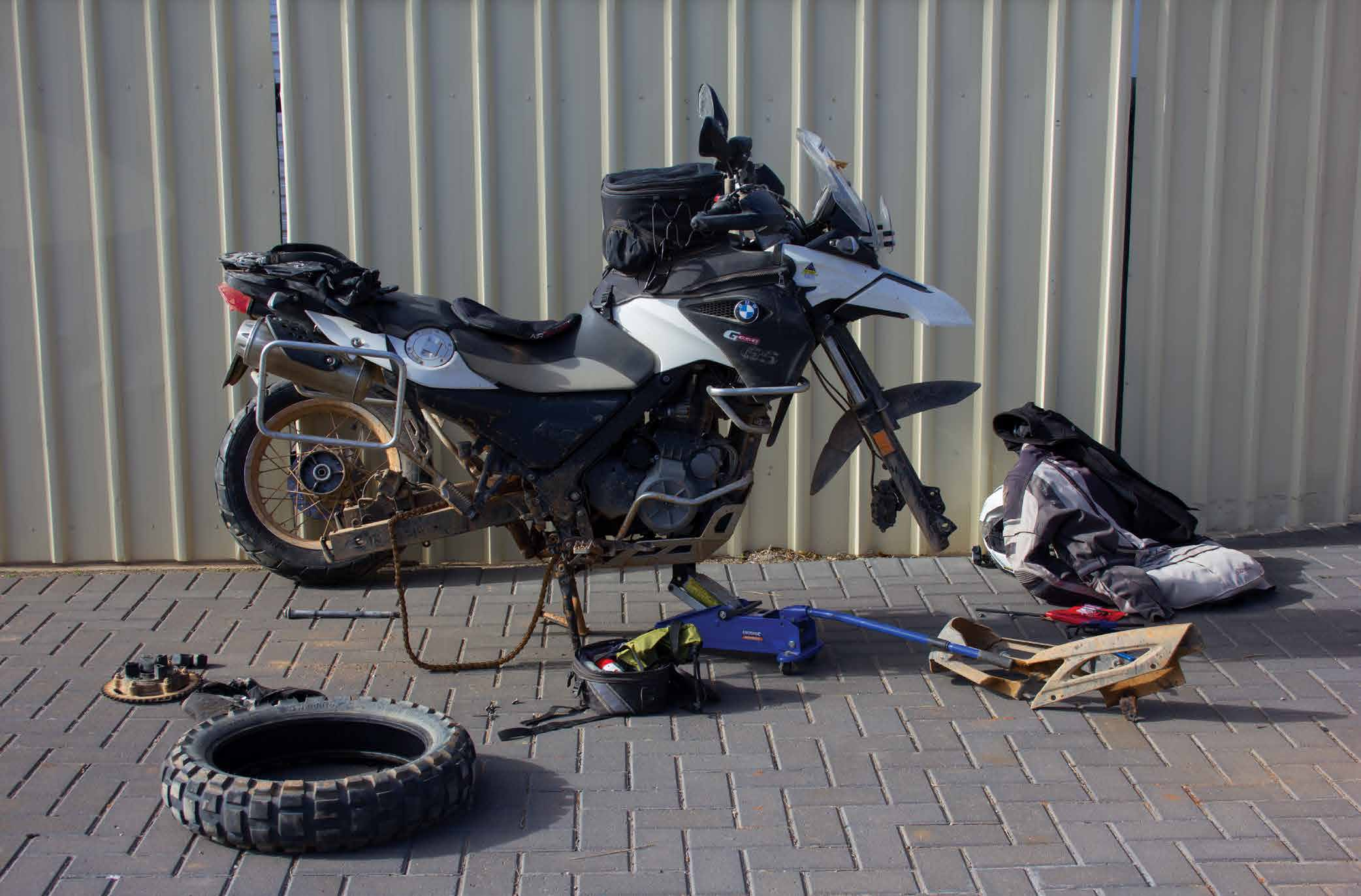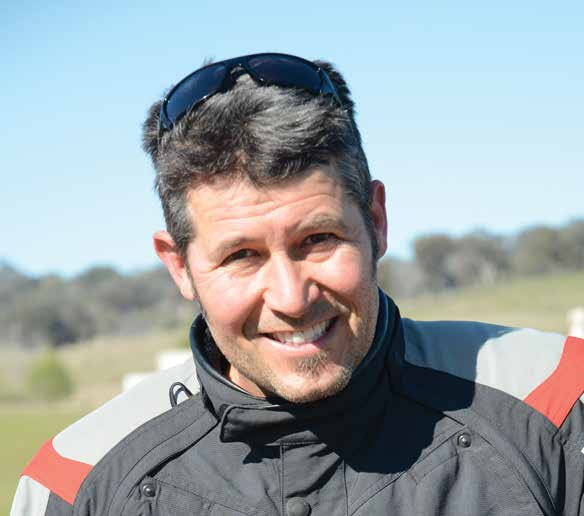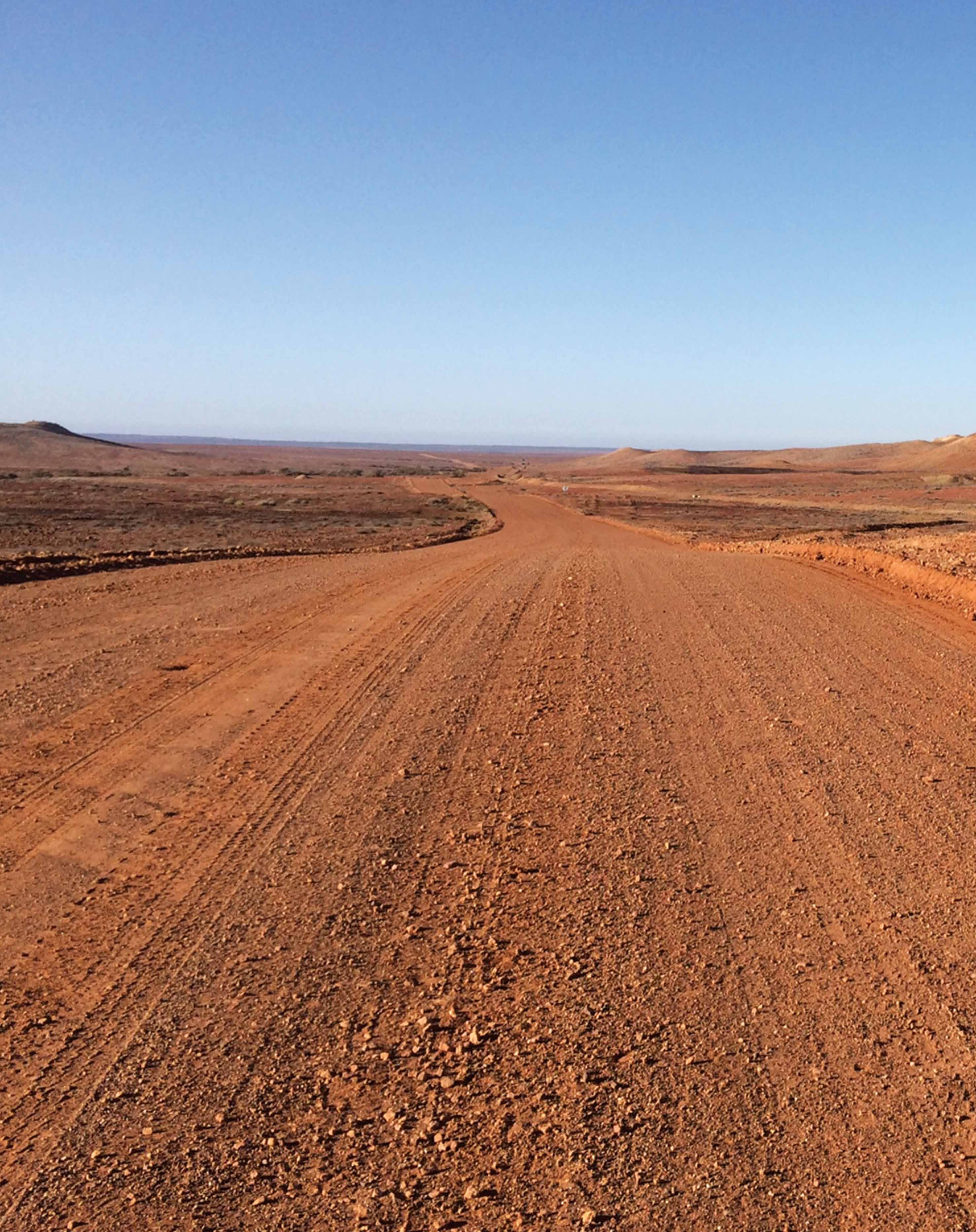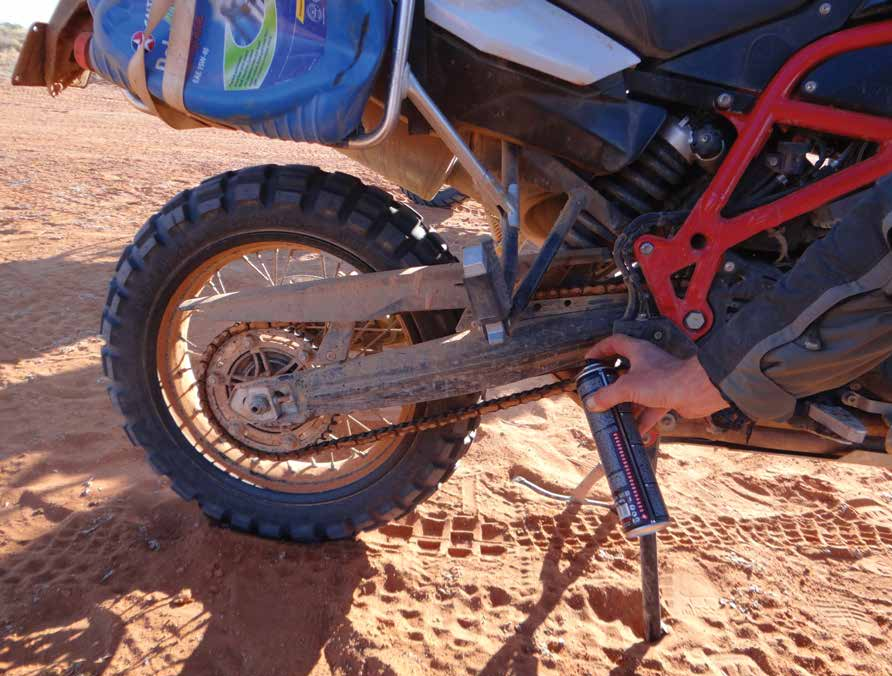- It’s we what do
- Cairns To Darwin
- Triumph 900 GT Pro
- Solo Mission: Weekend Blast To Bundarra
- Husqvarna 701 Enduro LR
- Two Heads Are Better Than One
- Adventurous Encounter
- GS Safari Is Go!
- Suzuki V-Strom 1050
- Lyndon Poskitt
- A Touch Of Paradise
- For Some Reason (FSR)
- Carrying Extra Fuel
- Paper Chase
- Andy Strapz Thermalz
- The Bag Lady with Mike Ferris
- Mechanical Sympathy with Miles Davis
- Lockdown Lowdown with Andy Strapz
- Karen’s Lockdown Highs And Lows with Karen Ramsay
- Checkout
- Fit Out
A little care can go a long way. A lack of care for a bike and its systems can mean it won’t go very far at all.

Love your bike and it will love you back.”
These are the classic words from Klaus Mueller during one of his Desert Sunset tours in Victoria about 10 years ago. I like the saying and have borrowed it regularly.
You and your bike are a team. As an adventure rider you end up in some remote situations and the last thing you need is a problem that could have been easily avoided.
When you think about it, most riders simply put fuel in their bike and ride it. There isn’t much of a preventative strategy at all. Good technique and some mechanical sympathy can go a long way to more successful adventure rides, less breakdowns and more fun.
Wheels and suspension
It isn’t uncommon for riders to apply small-bike riding attitudes to their generally bigger adventure bikes, bikes that have a lot more power and mass.
The temptation to launch off erosion mounds or fly through rocky sections doesn’t always go unpunished. Rim damage is quite common and there is lots of banter about ‘soft’ rims and ‘dodgy’ suspension. Generally, I see it quite differently.
You need to understand you and your bike’s capabilities and ride accordingly. Believe it or not, most of this sort of damage can be avoided with better technique and a smarter strategy. A term I like is ‘float like a butterfly’. It means to choose the right speed, choose good lines, and use body position to take the impacts out of the bike.
A typical scenario is:
• Rider not looking far enough ahead. Doesn’t see obstacles soon enough
• Riding too fast to be able to slow down before impact. Chops the throttle, grips the bike tight and holds on like Lego Man
• All the forces are multiplied through suspension to wheels and rim damage happens, even on quite small rocks, holes and so forth.The ideal scenario is:
• Look ahead, pick smooth, flowing lines. Slow down when situations are seen ahead
• Be smooth on the throttle, sometimes adding a controlled blip to make the bike float. Use body position to soak up impacts.
Done well the bike barely notices the same obstacles that cause wheel damage to Lego Man and his mates.
Adventure bikes’ suspension is generally medium to soft to provide comfort over long distances. Some riders see this as a weakness and spend a lot of coin to firm it up so it can handle bigger impacts. This can put even more stress on the rims. It’s all a bit of a balance, but technique always trumps.
 Miles Davis
Miles Davis
It can be hard being a clutch
Riding off-road is quite unique compared to many other types of riding or driving.
Clutch control is one of the most helpful skills a rider can have to navigate slow technical terrain, up hills and so on.
Whenever clutch control is mentioned, it goes hand-in-hand with throttle control.
Get a rider to attempt full-lock circles on a flat, firm surface and in about five seconds a pretty good idea of a rider’s clutch and balance skills will be obvious.
This exercise can challenge many experienced riders, too.
Many adventure bikes are powerful and torquey and with bad clutch control in some situations it’s possible to fry a clutch in about 60 seconds or 100 metres. I’ve seen it happen on trusty DRs, GSs, orange bikes…nothing is immune. It’s simple: high revs and high clutch slip is the killer.
On the flipside, slipping the clutch smoothly, generally in first gear at lower revs, will not wear or damage a clutch.
I think about two scenarios where less-experienced riders can be easily caught out.
First is getting stuck on hill climbs.
Sometimes the rider isn’t aware they got stuck in second gear, then they bring on heaps of revs and lots of clutch slip to try and get going and their clutch is in a world of hurt. Even in first gear this sort of thing can easily cook a clutch.
Second is riding in sand.
Taking off in soft sand you need some revs as the back wheel will need to be spinning, but you don’t need clutch slip.
Let the clutch out with a few revs, get the back wheel turning and hopefully the bike moving forward, then let the clutch out fully and manage spin, revs and drive with the throttle only.
 Taking off in soft sand you need some revs as the back wheel will need to be spinning, but you don’t need clutch slip.
Taking off in soft sand you need some revs as the back wheel will need to be spinning, but you don’t need clutch slip.
Love it long time
Another situation where I see clutches getting a tough time is riders attempting wheelies, especially on the road where there’s lots of grip.
There’s a bit more technique to wheelies that simply pulling in the clutch, adding lots of revs, then dumping the clutch.
This can put lots of strain on the complete drive train.
It’s important to know how much a clutch can contribute to technical riding control and to try to be smooth and sympathetic to it. Depending on your bike, you could get up to, or over, 100,000km/many years without any issue.
 “Love your bike and it will love you back.”
“Love your bike and it will love you back.”
Breathe easy
We can ride in some dusty conditions in this country and this can be really tough on airfilters and engines.
Some bikes come with paper filters, others oiled foam. Regardless of the type of filter you need to inspect and service it before your filter fails and your engine sucks a lungful of dust.
Foam prefilter socks are a great addition for adventure riding and can be easier to inspect and service than the main filter element.
 We can ride in some dusty conditions in this country.
We can ride in some dusty conditions in this country.
Inspect regularly
Before, during and after each ride you should be taking time to keep an eye on your bike. Check for loose or missing bolts. Use Loctite on key bolts and carry a few spares in your kit. Keep an eye on your oil level, know the correct procedure to check the level (warm engine and let sit? Dipstick or sight window? Wet sump or dry sump? And so forth) and be ready to add as required. If you’re crossing creeks and a bike tips over make sure you check the engine hasn’t had a guzzle and turned the oil to caramel milkshake.
This can kill an engine before you can say, “This will be expensive”.
And don’t forget to keep an eye on chains, sprockets and joining links, wheel bearings, brake pads, steering-head bearings, spokes and tyres for cuts, nails, screws and a stack of other potential problems. Kick your tyres at the end of the day and first thing in the morning so any issues can be dealt with before everyone is kitted up with engines running and ready to go.
 Don’t forget to keep an eye on chains and joining links.
Don’t forget to keep an eye on chains and joining links.
A bit of love
Keep your bike serviced, lubricate the chain and other parts as required. Have some key spares in your tool kit or in your workshop so you can quickly replace things before you begin a ride badly prepared…things like brake pads, chain links, airfilters and any other consumables particular to your bike.






















Comments